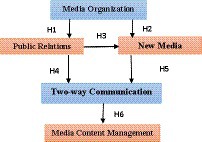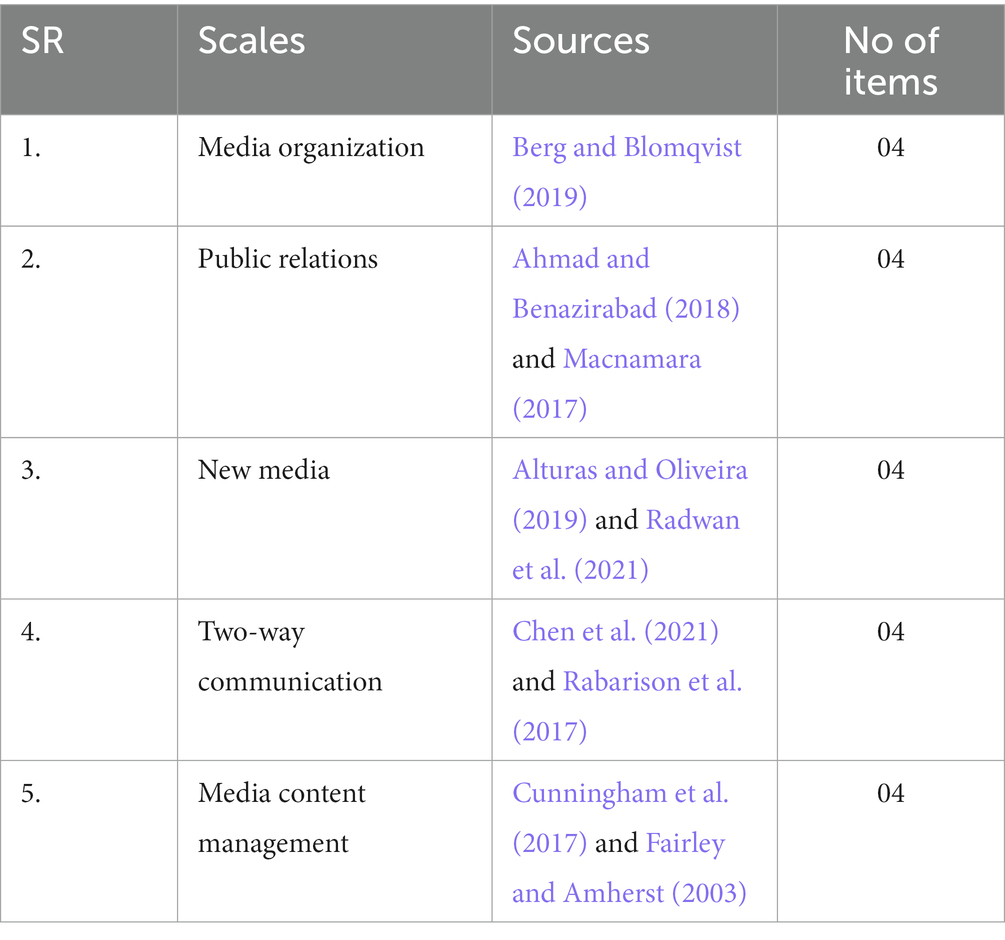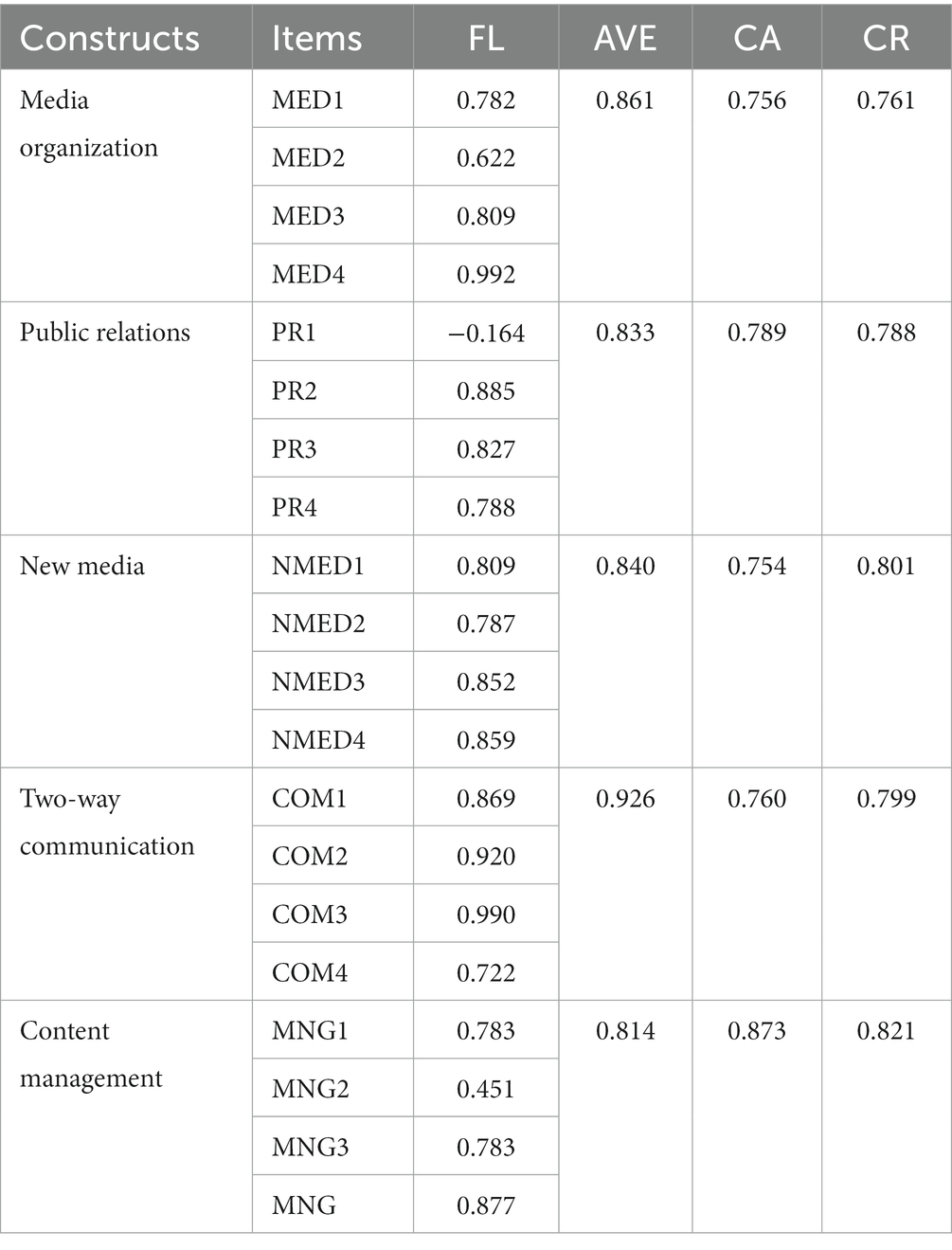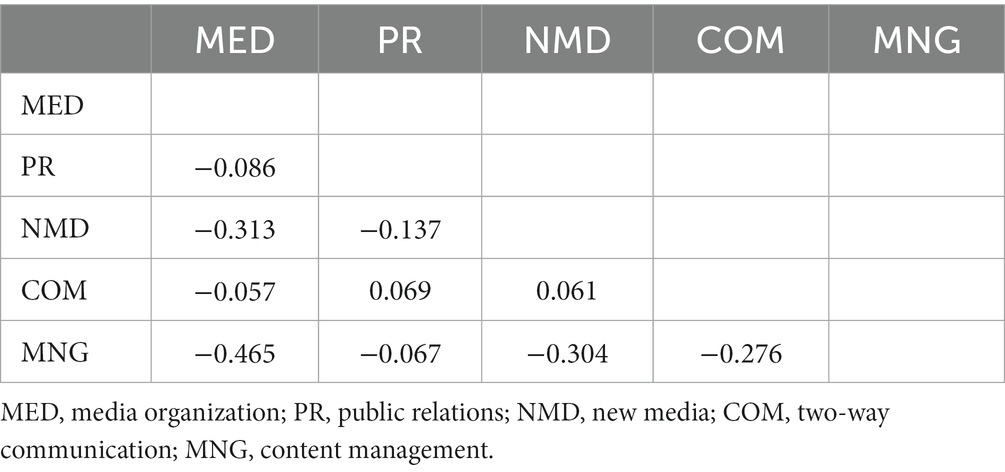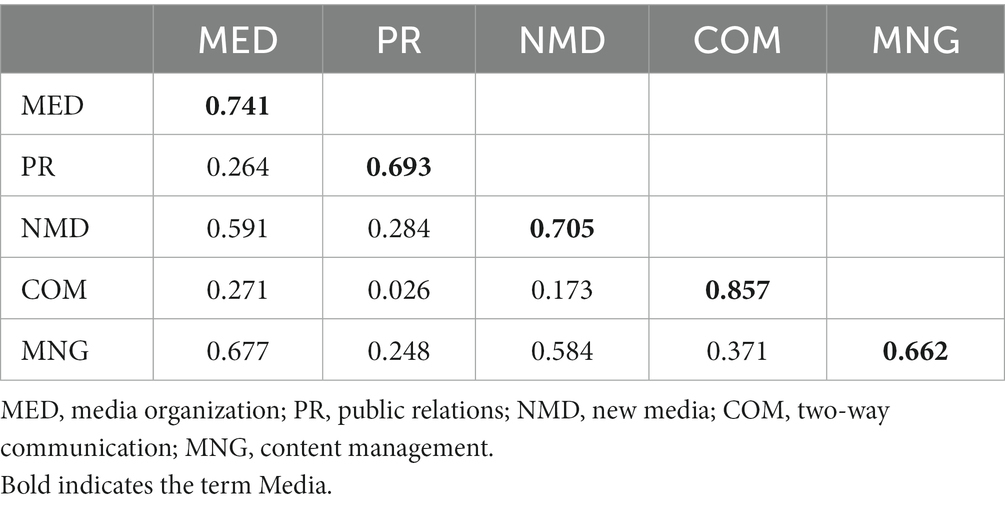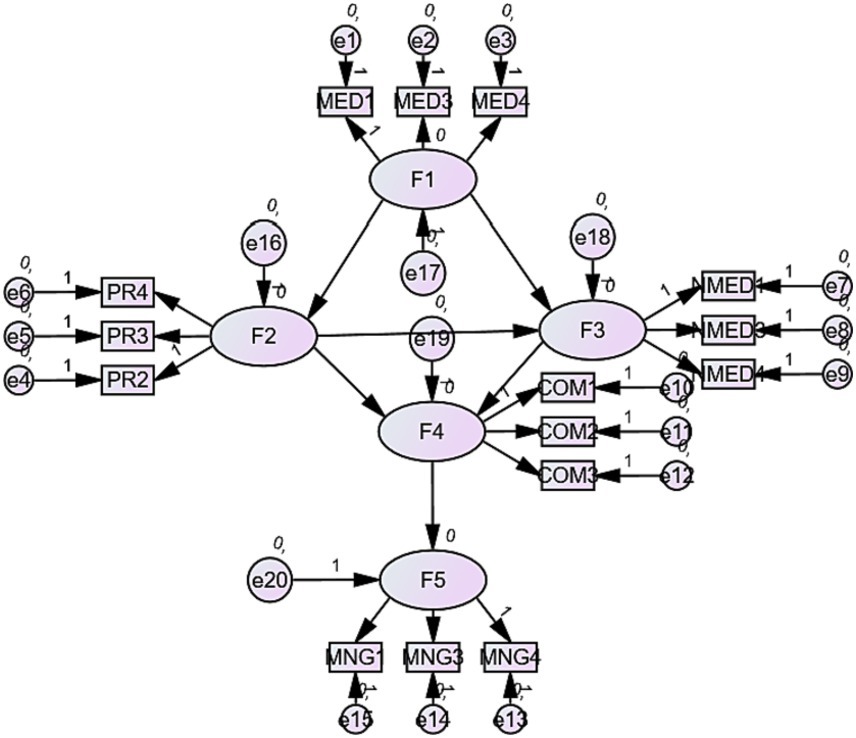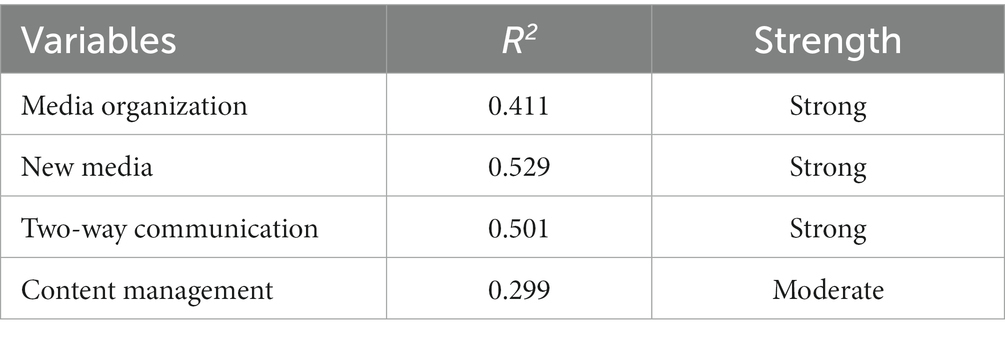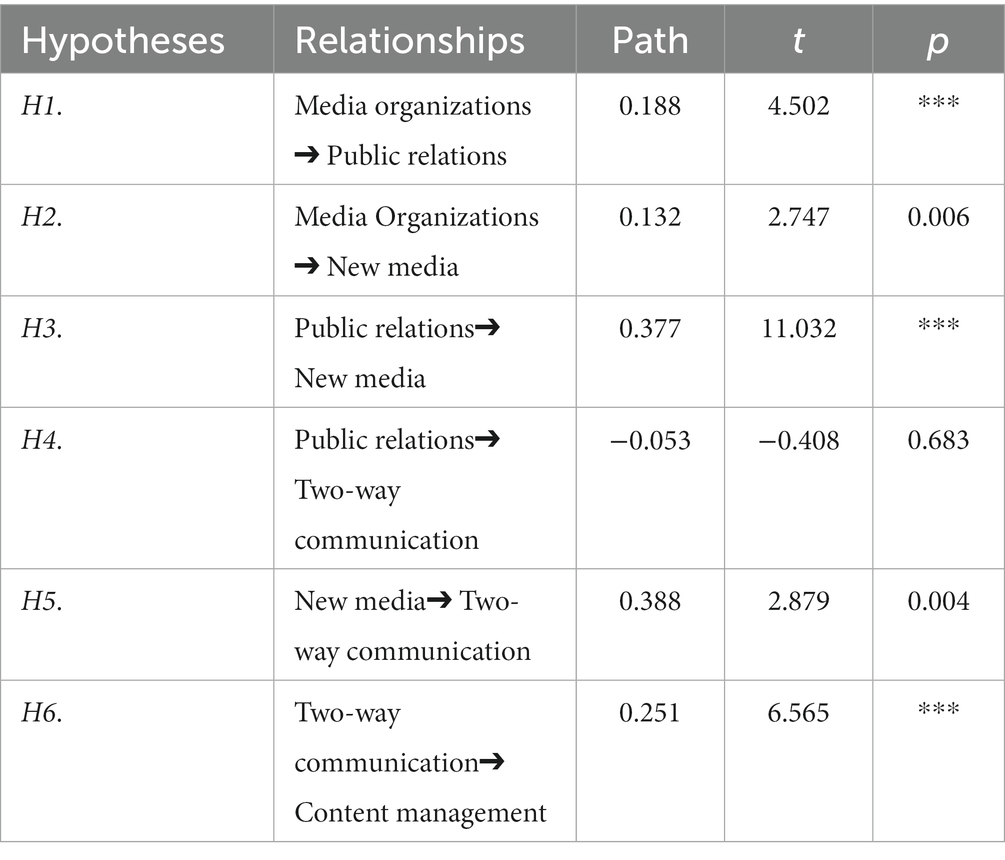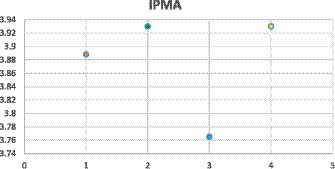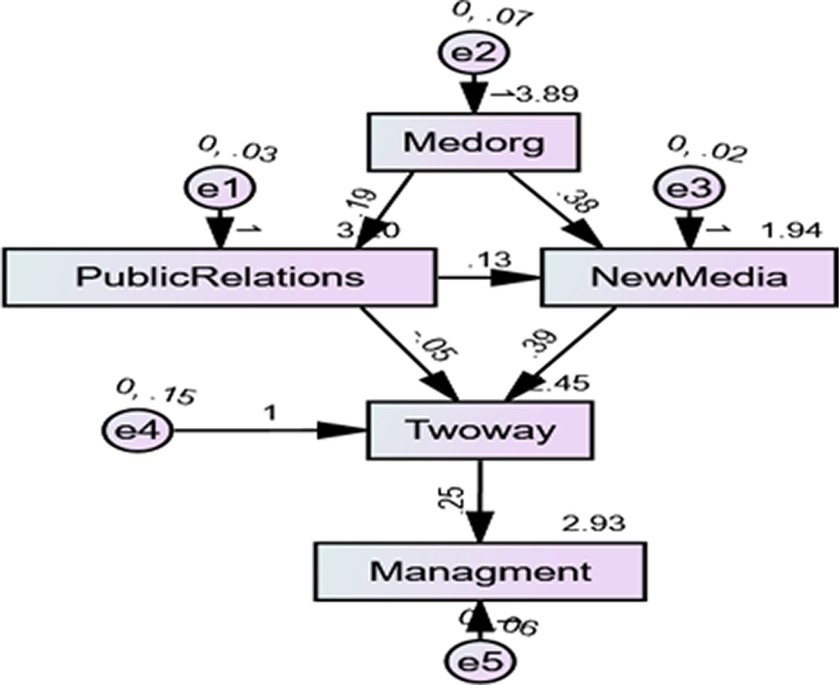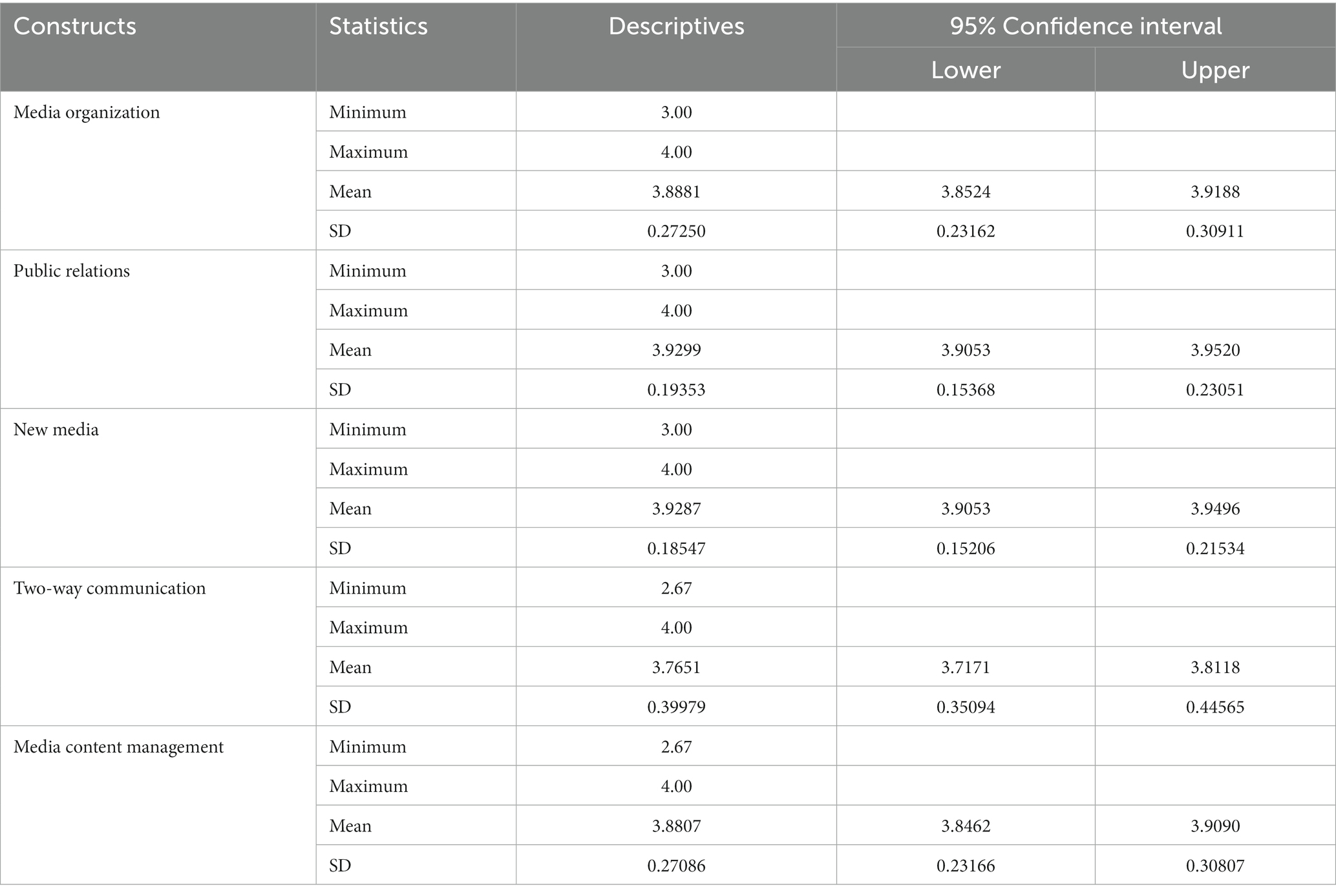Role of public relations practices in content management: the mediating role of new media platforms
- 1Public Relations and Advertising Department, Yarmouk University, Irbid, Jordan
- 2Emirates News Agency, Abu Dhabi, United Arab Emirates
- 3Department of Arabic Language, Faculty of Art and Humanities, Al al-Bayt University, Mafraq, Jordan
- 4Department of Business Administration, College of Business and Administration, Princess Nourah Bint Abdulrahman University, Riyadh, Saudi Arabia
- 5Radio and TV Department, Yarmouk University, Irbid, Jordan
Public relations practices are widely accompanied by communication and persuasion. Especially today, when new media platforms provide direct accessibility, communication through PR has become more improved. This research focused on media organizations in the UAE, with a special consideration given to their audience content management. The researchers applied the case study method and selected a sample of n = 280 individuals from n = 12 media houses currently working in the UAE. The results obtained by structural equation modeling (SEM) revealed that media organizations in the UAE pay significant consideration to public relations practices (p > 0.000) and new media adoption (p > 0.000). Moreover, both these public relations practices (p > 0.000) and new media adoption were also found to significantly focus on two-way communication. Consequently, this two-way communication is significantly affecting content management among these organizations (p > 0.000), leading to the design, evaluation, and alteration of content that is acceptable and liked by their audiences. Thus, it has been concluded that media content and its management is not a simple task. Audience and communication are two basic factors that play an important role in this regard. Furthermore, the role of public relations practices also enhances communication and content management practices, leading to even more constructive outcomes.
1 Introduction
Public relations practices are keenly focused on creating and sustaining relationships with customers and clients through communication processes. This communication is positive, and constructive and contains persuasive tactics that are appealing to listeners (Ahmad and Benazirabad, 2018). Notably, Edwards and Pieczka (2018) consider public relations experts to be creative and emotionally intelligent in different ways. The purpose is not only to communicate and send messages to their listeners but also to acquire favorable feedback from them. As a result, public relations experts in different organizations are considered highly important, having different functions with client-focused approaches (Qruni and Qrunig, 2017). Bashir and Aldaihani (2017) further described the function of public relations experts in a media organization as helping to maintain, foster, and improve relations with other organizations and audience members. PR practices in media organizations are focused on keeping an eye on the current trends being followed by other organizations and what the audience wants to see, read, and follow. All these functions are made possible through PR practices that are enriched with the communication process. As argued by Tworzydło et al. (2020), communication is the key process to increase understanding and achieve goals accordingly. As a result, when public relations practices are focused on audiences, they significantly foster the value of the media content. However, while researchers and critics sometimes differentiate between public relations and communication, they are intertwined and work hand in hand (Guidry et al., 2017). Sometimes, public relations also works as a one-way channel, especially when the information or content is imposed, and the focus is to have a positive public image. Nonetheless, in media organizations, public relations practices are mostly two-way, equally prioritizing audience feedback to further proceed with the production and dissemination of likeable media content (Gimaliev et al., 2020).
Similarly, public relations practices are significantly updated today (Gallicano et al., 2021). According to Savič (2016), the more organizations are focused on communication, the more they are likely to improve their PR practices. Thus, they perform more strategically and effectively to meet their goals (Al Olaimat et al., 2022). More specifically, media organizations across the globe are searching for and adopting new approaches to enhance their practices. Here, Michael (2021) cited an example of new media platforms being more effective, direct, and efficient in accessing audiences and obtaining their feedback. As noted, public relations scholars, experts, and critics have widely agreed that new media has changed the landscape of public relations practices (Elareshi et al., 2022). In addition to their ease of use, accessibility, and usefulness, new media platforms are justified resources to be used for public relations practices. In this regard, the empirical evidence on new media in public relations also attests to its role in transforming organizational functioning and content production systems (Rashid et al., 2019; Ureña et al., 2019; Radwan et al., 2021; Singh Apte and Upadhyay, 2022). As noted by Abdalli and Hassan (2019), the role of new media in public relations practices cannot be underscored or denied. Today, many media organizations rely on digital resources for their public relations practices. This dependency indicates several reasons that accelerate new media usage for PR purposes. Particularly, this trend seems more followed by media organizations, where content production and dissemination primarily depend on audience response and feedback (Ahmad and Benazirabad, 2018). To establish a better understanding of the subject of new media, it is important to explore the impact of digital platforms on public relations practices in content management and the advances in social media research. Subsequently, the current study highlights the impact and promise of new technologies and aims to understand how the digital transition can be harnessed to develop and enhance local public relations practices. Similarly, the study of the advances in public relations research has identified multiple emergent themes in the existing corpus, thereby furthering our understanding of advances in new media platforms (Dacko-Pikiewicz, 2021).
1.1 Study aims and objectives
It is notable that public relations has long been addressed by researchers in the UAE. However, their focus remained on other factors such as issues in PR practices (Al-Jenaibi, 2015), PR in crisis management (Kamil, 2020), and PR practices in the Emirati banking sector (Muhammad et al., 2019), among others. Yet no study has examined PR in media content management, indicating a primary empirical gap. Thus, to fill this existing gap, this study focused on examining the role of new media platforms in the media content management process. No study has examined public relations in media content management in the Emirati context; rather, most studies have dealt with reputation management and the effects of multimedia in the Arab region, specifically in the Emirates, but they provide valuable insights into the communications landscape and the role of social media in shaping public opinion and guiding consumer behavior. Therefore, in the current study, the researchers focused on public relations practices experts in Emirati media houses who communicate through new media to manage their content according to their audience needs and demands. To provide systematic and empirical evidence of the phenomenon under study, the researchers divided this research into six different sections as the purpose was to provide systematic and empirical evidence. The first section involves an introduction to the topic, problem of the study, objectives, and a brief overview of mass media in the United Arab Emirates. The second section involves a review of the literature, and the third section involves the theoretical support that further assisted in designing the conceptual model of the current research. The fourth section involves the methodological approaches, and the fifth section involves the data analysis and findings of the current study. Finally, in the sixth section, the researchers have discussed the results, and conclusions are made.
1.2 Media in the United Arab Emirates
After the British occupation ended in 1971, the mass media landscape in the United Arab Emirates started to evolve. Since then, media platforms have been working under governmental control, being equally controlled and regulated by the National Media Council. Today, there are a total of 19 newspaper organizations, out of which 7 are published in Arabic and the remaining 12 in English (Addi et al., 2021). Furthermore, there are 14 independent radio stations also working in the country, and the rest are government owned. Regarding television, the first TV station in the United Arab Emirates, called “Abu Dhabi Television,” was established in 1969, which led to the beginning of the television era in the 1990s (Aleisaei, 2019). However, currently, the trend of chain ownership is also being followed by the Emirati media organizations. The major media organizations include the MBC Group (UAE), Arab Media Group, Dubai Media Incorporated, Sharjah Media Corporation, and Abu Dhabi Media Incorporated. Dubai Media Incorporated, also known as Emirati Media Incorporated, is owned by the government (Del Chiappa, 2017). It is also notable that these media organizations acknowledge online platforms as equally important for their visibility, content production, dissemination, and interaction with their audiences. As a result, when the COVID-19 outbreak emergency happened, Emirati mass media platforms not only worked to send their content through conventional resources but also resorted to new media platforms for content dissemination and interaction purposes (Myrzabekova, 2021). The UAE is witnessing continuous development in new media as the government seeks to develop national media content to keep pace with developments and changes in the media landscape. These developments include the use of artificial intelligence and future new media in creating media and technological content (Radwan et al., 2021). The UAE is considered a leading destination for media scene makers as it hosts many major media companies and international media forums. New forms of media in the UAE include social media and the Internet; indeed, the UAE has a high Internet penetration rate and ranks first in the world in the use of social media. The UAE government is working to develop a comprehensive media system that includes modern mechanisms, tools, and content that keep pace with the developments and changes taking place in the media landscape. The UAE is also witnessing growth in the new media sector, with many radio and television stations that transmit news and information (Radwan et al., 2021).
2 Literature review
2.1 Online platforms and media content
An online platform is defined as a means of communication through which the user creates an account that enables them to communicate via the Internet with other people electronically. Online platforms and social networking include many different applications and tools (Wang et al., 2023) that are formed into Internet apps, which are classified as social media. Social media technology takes many forms, including blogging, forums, photo sharing, video blogging, and music and audio sharing via the social networking protocol (Al Jwaniat et al., 2023). It can connect many types of software that enable the use of online platforms and online media content to improve online communication between social media users (Facebook, Tik Tok, YouTube). The term “media content” refers to information and experiences disseminated in specific contexts, via digital and traditional media, for the benefit of end users and audiences in various fields (Tawafak et al., 2023). Media content can include many forms, including newspaper articles, books, video and audio clips, photos, graphics, graphs, charts, animation, games, applications, educational platforms, content management, and public relations. Internet and social media platforms can be used to publish and manage media content and interact with the public (Hatamleh et al., 2023).
2.2 Public relations in media organizations
According to Dacko-Pikiewicz (2021), with an abundance of information available through mass media platforms, organizations focus on constant communication with their clients and audiences. In particular, media organizations pay keen attention to their audiences with the aim of creating and sharing content that is mutually acceptable and liked by their audiences. Lingel (2020) considers interaction and communication with the audience as one of the key considerations for media organizations. For this purpose, public relations departments and experts are among the crucial factors that ensure continuous communication with audiences at different levels. Referring more specifically to the role of public relations, Berg and Blomqvist (2019) argued that PR practices are creating a culture of dialogue and communication between organizations and individuals. Earlier, the role of public relations was to inform the public, but today, this role has been transformed and enhanced to communication. The focus on clients and their feedback is comparatively increased. As a result, communication is two-way, where clients are not only listening to what organizations have, but organizations must also listen to what their clients expect from them (Valentini et al., 2018). Although many researchers consider the role of public relations as like that of advertising and promotion, prioritizing audience feedback is an important element that differentiates between PR and advertising in organizations, especially media-based organizations (Navarro et al., 2017). Therefore, media organizations are considered a major means of communicating with the public, and the field of public relations depends greatly on effective communication. The media can be a means of conveying brand or institution messages effectively, and it can be said that there is a close interaction between media organizations and the field of public relations; indeed, media organizations present a powerful means that can support public relations strategies and contribute to achieving their goals (Berg and Blomqvist, 2019).
H1: Media organizations have a significant effect on public relations.
2.3 Organizations preferring new media
Today, organizations search for new approaches to increase their accessibility to both other organizations and individuals. However, this access depends on the organizational objectives and their business requirements (Radwan et al., 2021). According to Allagui and Breslow (2017), when organizations are client centric, they aim to reach the masses, interact with them, and gather their feedback to improve existing services and adopt new ones according to their needs and demands. For this purpose, Toledano and Avidar (2019) cited an example of surveys and older ways of gathering feedback and responses through postal services. In this regard, organizations would reach their clients and gather their responses in handwritten forms. However, today, trends have changed due to new media resources and platforms.
According to Lee et al. (2015), new media have tremendously increased access to clients and consumers. Traditional methods of response gathering are widely altered as organizations prefer virtual digital platforms to communicate. This is further validated by Valentini et al. (2018), who consider new media as facilitating maximum communication and interactivity. These platforms not only facilitate access to the audience but also provide the audience with access to the organizations they want. Here, Habes et al. (2023) cited an example of public awareness and messages sent to the Pakistani audience during the COVID-19 outbreak. According to the researchers, the relevant campaigns were effective yet required audience feedback as to their adoption of the measures to mitigate the virus transmission process. Consequently, the messages being circulated through conventional platforms were also disseminated through new media resources, which further helped to observe the audience behavior as the feedback to the relevant messages, leading officials to improve and even change the strategies as per the requirements (Iqbal and Khan, 2021).
H2: Media organizations have a significant effect on new media.
2.4 New media in public relations
According to Edwards and Pieczka (2018), every organization has strategies for their public relations. Whether promoting or selling products or promoting an idea, public relations practices are of greater concern to them. If organizations lack effective communication, it means their public relations practices have a weak strategy. As noted by Bashir and Aldaihani (2017), a strong public relations plan that is built with close attention to clients’ details is more likely to be strategically organized. However, Gimaliev et al. (2020) have considered a strategically organized plan to be focused on the clients with the aim of gathering maximum feedback and details about their needs, which can be later fulfilled by the improved service quality.
Similarly, Froment et al. (2017) emphasized selecting the right media type for PR practices. In this regard, new media is considered as comparatively more useful, with its potential to obtain and coordinate all the necessary information from both clients’ feedback and observing their behavior online. Hall (2020) has considered new media for public relations as “online media relations” that can be time consuming yet more value to an organization by improving its communication practices. Here, Bergstrom and Poor (2022) cited an example of interaction through Facebook, LinkedIn, Twitter, and other virtual resources by many multinational national organizations. According to Valentini et al. (2018), a crucial difference between digitalized public relations and conventional public relations is all-time availability. New media enhances this availability, and communication is feasible whenever the communicators want it.
H3: Public relations has a significant effect on new media.
2.5 Two-way communication in public relations
The two-symmetrical model of communication and public relations provide theoretical support to the current research. According to Matthee (Matthee, 2011), two-way symmetrical model is considered as one of the most ethical and practical approach of communication today (Kent et al., 2020). As noted earlier, communication is an effective way to share and receive information between communicators. Through communication, it is easy to send a message and monitor what others respond about it (Rodriguez, 2016). As noted by Navarro et al. (2017), feedback is an integral part of communication. In particular, when communication is goal oriented and focused on responses, communicators necessarily follow the rules of two-way communication. As noted by Tankosic et al. (2016), two-way communication is key to creating and sustaining great mutual understanding. It is an important communication pattern as it not only builds trust but also improve the free flow of ideas at every level. Here, Toledano and Avidar (2019) cited an example of an advertising company introducing and promoting products to attract audiences. The type of message was focused on attracting the audience’s interest and their buying behavior as the feedback or response to the communication process. Similarly, in terms of public relations practices, Lane (2018) has considered the role of PR practitioners as not only sending the message but also adopting problem-solving approaches. As audiences can have queries or confusions, two-way communication patterns in public relations can help to answer them all in an effective and efficient manner. Toledano and Avidar (2019) further noted that encouraging two-way communication can help an organization to flourish at its maximum. When PR practices bolster two-way communication, external communication with clients and audiences improves, helping an organization to reach its goals. When the audience or clients are more vocal about their needs and demands, an organization can work accordingly and fulfill their expectation in a better possible manner (Michael, 2021).
H4: Public relations has a significant effect on two-way communication.
2.6 New media and two-way communication
Although humans and language are considered the basic components of communication, this proposition seems upgraded by certain components today. This era is characterized by informing, with the concept of information communication technology (ICT) having transformed the landscape of communication processes (Tankosic et al., 2016). Yuan (2017) has considered ICT to comprise powerful tools of communication where both one-way and two-communication are followed at both the micro and macro levels. In particular, in organizations where public relations practices are focused on two-way communication approaches, the role of technology is of greater significance.
In this regard, Macnamara (2017) has considered new media an important source of improving public relations practices across the globe so that it may flourish. Organizations where public relations experts resort to new media continuously monitor and evaluate a company’s performance through client feedback. According to Ertürk (2019), viewing relations with clients and audiences as a crucial factor is a key management consideration for public relations experts. Moreover, using new media platforms also contributes to a company’s reputation at many levels. Thus, Roberts-Bowman (2017) has considered the presence of new media as an important approach for public relations that helps to maintain a constant voice across different communication platforms and increase the market presence of an organization.
H5: New media has a significant effect on two-way communication.
2.7 Two-way communication and content management
In discussing the technological transformation and new media as a part of public relations practices, it is important to highlight their role in facilitating communication at every level (Radwan et al., 2021). For example, during political events, media organizations and campaigns creators strongly consider the ongoing trends at the social and political levels. These trends help to brainstorm and highlight not only new campaigning ideas but also what people like and pay attention to Alturas and Oliveira (2019). According to Radwan et al. (2021), media content design, production, and management are all performed when audience feedback is carefully obtained. It is important to design and shape content in accordance with the audiences’ interests. In this regard, the researchers consider media content as designed and managed by resorting to two-way communication patterns.
Although audience feedback is not a new phenomenon, it is of much importance due to new policies and strategies. In particular, when online communication helps to access audiences, content management is feasible with just a single click (Bergstrom and Poor, 2022). According to Froment et al. (2017), despite the communication and media focus on audience engagement, it primarily depends on the type of communication. For example, one-way communication is declarative and mostly undermines an audience’s critical thinking and opinion sharing capabilities. Two-way communication, on the other hand, is considered more motivating, magnifying the importance of audience feedback and increasing an audience’s critical thinking and opinion sharing capabilities (Yuan, 2017). Similar patterns of two-way communication were seen during the SARS outbreak in the Middle Easter. Local governments not only provided information about measures but also conducted several online surveys, monitored social media profiles, and designed healthcare content accordingly (Valentini et al., 2018).
H6: Two-way communication has a significant effect on media content management.
3 Theoretical framework
3.1 New media theories approach
The approach of new media theories lies in understanding and analyzing the impact of technology and modern media on society and culture (Yuan, 2017). According to Matthee (2011), new media theories provide a framework for understanding how technological development affects change in values and culture and help explain how social behavior and cultural interaction develop under technologies. New media theories also provide a framework for understanding how media content spreads through digital media, which contributes to studying its impact on society and culture (Sarwar et al., 2023). Likewise, these theories highlight how digital media influences the formation of individuals’ identities through their participation in digital content and social media. New media theories explain how the economic structure of the media affects the quality and quantity of media content produced and how it is distributed in society (Yuan, 2017). The theories also focus on the role of the consumer as an active actor in the process of consuming media content, which helps in analyzing how the individual shapes their media experiences (Radwan et al., 2021). Thus, the new media theory approach contributes to opening new windows of understanding of the social and cultural transformations that occur as a result of technology and digital media. New media theories also focus on the role of the audience as an active actor and participant in the media process (Pasha et al., 2022). In content management in public relations, audience interaction with content is vital as content is designed and managed in a way that encourages interaction and participation (Radwan et al., 2021).
3.2 Two-way symmetrical model of communication and public relations
The two-way symmetrical model of communication and public relations provides theoretical support to the current research. According to Matthee (2011), the two-way symmetrical model is considered one of the most ethical and practical approaches of communication today. It is focused on communication, which should be built on mutual understanding and an equal opportunity to share and receive the message between both the organization and other parties. As validated by Gruing (2001), the two-way symmetrical model follows a greater social responsibility. An organization following the two-way symmetrical model of communication and public relations strongly prioritizes its workers and audiences to gather their opinion and, thus, work accordingly. In a similar context, this study applies and follows the relevant model, assuming that media organizations in the United Arab Emirates are giving potential importance to communicate with their audiences (Amin et al., 2019). This communication helps them to create and disseminate desirable content that will be accepted by their audiences (feedback). However, compared to the traditional approaches to communicate with audiences, these media houses have their official pages on new media platforms, which are marked by their ease of use and increased accessibility. As a result, greater accessibility to the public facilitates access to their opinion, which further helps them to gather their opinion and shape their content accordingly. Abdalli and Hassan (2019) also consider new media as facilitating communication between PR experts and audiences. As noted, new media not only increases access to audiences but also helps to gather their feedback. Once the audience feedback is gathered, PR experts determine their needs and demands, which further helps organizations in their media content management and production process (Figure 1).
4 Research methods
This research involved the case study method. As noted by Crowe et al. (2011), the case study approach is a multifaceted and complex method that helps to assess a phenomenon in a real-life situation. The researchers applied structured questionnaires for the data gathering purposes (Habes et al., 2021b). The scale and items of the questionnaires were adopted from existing research that is summarized in Table 1. Notably, the questionnaire was designed on a five-point Likert scale (Pasha et al., 2021), with n = 4 items for each variable. The data gathering was performed from 21st April 2022 to 15th June 2022. After the data gathering (Pasha et al., 2022), the researchers manipulated and coded data for the analysis purposes. As the current research involved structural equation modeling, both Statistical Package for Social Sciences and Amos Ver. 26 were employed.
4.1 Sample selection technique
The population of the current research was composed of public relations practitioners currently working in media houses in the United Arab Emirates. However, as per the research rules, the researchers had to select a subgroup of individuals (Elbasir et al., 2020); thus, the researchers selected n = 12 media houses (their regional offices) currently working in the four states of the United Arab Emirates. Furthermore, the researchers selected a sample of n = 280 individuals as the study requirements and design. According to Howard (2016), studies that are based on structural equation modeling should contain a minimum sample size of n = 200 individuals to ensure the reliability and generalizability of the results. In this regard, the sample size of n = 280-was ideal for this research. Finally, the researchers performed data collection by personally visiting the media houses in the selected locations. As the study was focused on public relations practices, the researchers used convenience sampling techniques and only selected PR practitioners operating in the selected organizations. According to Taherdoost (2018), despite convenience sampling having received much criticism from the researchers, it is one of the most preferred sampling methods. However, the relevant techniques help researchers to select and gather data from the most suitable respondents that have a direct and real-life experience of the phenomenon under study (Habes et al., 2021a). Thus, after the data collection process, the researchers collected the questionnaires and carefully checked them before the coding and data analysis. Out of the n = 280 questionnaires, n = 271 were finalized for the further proceedings, indicating a response rate of 96.7, and n = 9 questionnaires were either incompletely filled out or missing.
4.2 Ethical considerations
The researchers first took a written permission, signed by the branch managers of the relevant offices regarding the data collection process. Furthermore, the researchers provided the respondents with informed consent as an important consideration suggested by Gov (2013). The respondents were briefed about the research problem, purposes, and the usefulness of the study results. The researchers also assured the respondents that their personal data would be kept confidential and not be used for any personal or commercial purposes.
4.3 Common method bias
According to Apuke (2017), common method bias (CMB) occurs when the variation in the gathered data is caused by the research tool instead of the actual responses that it aims to obtain. In simple words, common method bias (CMB) is caused by the tools rather than the data. In this research, the researchers tested the common method bias (CMB) by using Harman’s single factor score (Kock, 2021). The results revealed the total bias at 36.1%, which is smaller than the threshold value of 0.50, indicating that the CMB did not affect the gathered data.
5 Analysis and results
5.1 Convergent validity
Hussain et al. consider convergent validity as determining the extent to which the scale items are related to other scales of the same construct (Hussain et al., 2018). Precisely speaking, convergent validity provides a pathway to determine the pathway to assess the internal consistency of the measurement model (Nawanir et al., 2018). Examining the internal consistency of the measurement model indicated most of the factor loading as surpassing the threshold value of 0.05. Moreover, the average variance extracted values (0.814–0.923) also remained higher than the relevant threshold value of 0.5. Regarding construct reliability, the analysis revealed the composite reliability values as ranging from 0.761 to 0.829 and the Cronbach alpha values as ranging from 0.754 to 0.873, thus surpassing the threshold value of 0.7. Thus, the convergent validity analysis was established, indicating the questionnaire items as internally consistent (Koonce and Kelly, 2014). Table 2 summarizes the convergent validity calculations.
5.2 Discriminant validity
This research further involved discriminant validity to determine whether the research constructs were not highly correlated. As the constructs were weakly correlated, the higher the discriminant validity therefore was (Samuels, 2016). The researchers further examined the discriminant validity by applying the standard two-criterion approach including the heterotrait–monotrait (HTMT) ratio and Fornell–Larcker criterion (Howard, 2016). The researchers first utilized the HTMT ratio and manually calculated it. The results revealed the HTMT value at 0.081, which is lower than the threshold value of 0.90 suggested by Henseler et al. (2015). Furthermore, the Fornell–Larcker criterion revealed that all the squares of the average variance exacted values were greater (0.662–0.857) and had a relatively weaker correlation with each other (Wang et al., 2015). Thus, the findings indicated that the discriminant validity of measurement model was affirmed (see Tables 3, 4).
5.3 Goodness of fit
Narsky considers goodness of fit an important component of measurement model analysis in structural equation modeling (SEM) as it determines the extent to which the observed data fit with the expected data under the study model (Narsky, 2004). The goodness of fit in this study revealed the Chi-square value at x2 = 0.066 (10) and probability value at 0.002. Moreover, the non-fit indices value remained at 0.201 and standardized root mean square (RMSEA) value at 0.370, thus lower than the threshold value of 0.085, indicating that the observed data fit the expected observations with the normal distributions. Figure 2 illustrates the goodness of fit.
5.4 R2 analysis of variance
R2 analysis, also known as coefficients of determination R2, determines the extent to which the exogenous variables can predict the research outcomes (Figueiredo Filho et al., 2011). Primarily, it is based on a number between 0 and 1, indicating the predictive power of the independent construct(s) (Dastres and Soori, 2021). R2 analysis in the current study (see Table 5) revealed 41.1% variance in media organization, 52.9% in new media, 50.1% in two-way communication, and 29.9% variance in content management. Thus, variance ranged from moderate to strong among the latent variables.
5.5 Hypotheses testing
Finally, the researchers examined the causal relationships between the proposed study variables by using the path analysis in the structural equation modeling (Mazouz, 2019). Although regression analysis can also determine the strength and nature of relationships between variables, path analysis provides relatively more details about the paths of relationships in a better possible way (Hair et al., 2021). Thus, the path analysis in this study also contained path values, regression weights, and significance values (see Table 6). Consequently, it was revealed that the effect of media organizations on public relations remained significant, with the path value at 0.188 and significance value at p > 0.000. The validation of H1 indicates its consistency with the study conducted by Toledano and Avidar (2019), who consider media organizations as actively incorporating public relations and communication practices as a part of their strategic functioning and development. Furthermore, H2 of the current research was focused on the significant effect of media organizations on new media. The relevant hypothesis was adopted from the notion that media organizations are focusing on their new media usage and presence. These organizations use new media to access the public and interact with them for different purposes (Valentini et al., 2018). Analysis revealed that the relevant hypothesis is valid, with the path value at 0.132 and significance value at p > 0.006.
Furthermore, H3 in this research proposed a significant effect of public relations and two-way communication. The relevant hypothesis is based on the primary assumption about the role of public relations in creating and sustaining communication under the symmetric model of communication and PR (Tankosic et al., 2016). However, H4 remained insignificant, with the path value at −0.053 and significance value at p > 0.683, indicating that the results remained inconsistent with assumptions where PR practices in Emirati media houses follow two-way communication (Roberts-Bowman, 2017).
Furthermore, the effect of new media on two-way communication (H5) was consistent with the fact that existing literature on new media and communication considers it as facilitating two-way interactivity among users (Sembor, 2017). The results revealed the path value at 0.388 and significance value at p > 0.004, indicating compatibility with the proposition regarding new media for two-way communication. Finally, the researchers assumed a significant effect of two-way communication on media content management (H6). As noted by Aydin et al. (2021), interaction with audience is an important way to design, choose, and display the desirable media content. Organizations that focus on interaction with the audience are more likely to generate suitable content, therefore leading to improved reputation and acceptance among the public. Thus, the analysis revealed the path value at 0.251 and significance value at p > 0.000, indicating consistency with the arguments of Ahmad et al. (2019).
5.6 Importance performance map analysis
Importance performance map analysis (IPMA) is an additional step in structural equation modelling that provides an overview of the causal relationships between study variables (Aprilia et al., 2022). IPMA graphically illustrates the performance of latent variables in a graphical form, also known as a “map” (Henseler et al., 2015). Importance performance map analysis (IPMA) in the current research (see Figure 3) indicated public relations (PR) as the highest scoring variable (3.929), while content management (MNG) remained the second highest scoring variable (M 3.921). Followed by media organization (3.88), two-way communication remained the lowest scoring variable.
6 Discussion
The two-way symmetrical model of communication proposed by James Gruing’s Excellence Theory aims to examine organizations as focusing on attaining mutual benefits. In other words, this model implies that organizations ensure mutual benefits for themselves and their audiences (Valentini et al., 2018). The basic conceptualization of the Gruing model relies on communication as a primary negotiation between the organization and their public, further fostering mutual understanding and interest (Ahmad and Benazirabad, 2018). A similar approach has been further modified in terms of new media providing different platforms through which people can voice their opinions and organizations can obtain maximum benefit from their feedback (Rahi and Ghani, 2017). According to Aleisaei (2019), the two-way model of communication shows a greater consistency with the propositions about the role of new media in audience feedback and content management. Despite the role of new media, in general terms, remaining prominent, its relevance with PR practices for content management is debatable in many regions, including the United Arab Emirates. As noted by Yuan (2019), the two-way model of communication is very different from the stereotypical perception of the role of public relations of persuading by using deceptive, one-way practices. Rather, public relations experts ensure transparency and equal communication opportunities for all, which further indicates the relevance and significance of two-way communication among them (Tankosic et al., 2016). Public relations practitioners also believe that organizations, individuals, and the public should use communication to modify behavior instead of controlling how others should think and behave (Lee et al., 2015; Figure 4).
Similarly, the focus of this study also remained on public relations practices among Emirati media organizations. Although there are both private and public sector media organizations, the researchers selected the relatively suitable ones to assess their content management. Notably, the first theme of the questionnaire was followed by further root questions, overall investigating the communication patterns and approaches used by the relevant media organizations (see Table 7 for descriptives). Our respondents revealed a democratic communication approach that further helps PR professionals to boost their confidence and provide them with more opportunities to think of and apply creative communication practices (Berg and Blomqvist, 2019). Regarding the second theme and root questions, the focus remained on examining the respondents’ answers about their organizations and public relations practices. The respondents widely agreed with the fact that their organization put a social focus on public relations practices and continuously apply, evaluate, and monitor their PR practices (Abdelrahman Alawaad, 2021). The respondents also addressed and agreed with their organizations’ preferences for new media platforms as providing effective, direct, and efficient communication opportunities. These services, as they indicated, are widely accompanied by ease of access and useful outcomes that further accelerate new media adoption among their organizations (Alghizzawi et al., 2023).
Furthermore, the respondents also indicated that their public relations practices through new media follow two-way communication patterns. The relevant two-way communication, according to the respondents, is focused on obtaining audience feedback on certain media content. Their feedback is used to evaluate content and design new content accordingly (Froment et al., 2017). Finally, the respondents agreed that content management, being a strong consideration for their organization, is influenced by two-way communication. As also argued by Ahmed and Khan (2019), the audience as receivers of media content can evaluate well its quality and appropriateness. When dealing with media content, two-way communication can also help content designers and creators to think with more creativity and vigilance.
7 Implications and conclusions
This research has some implications. Firstly, it underlines the importance of building enhanced relationships between PR practitioners and media outlets. Trust and collaboration can be strengthened by fostering two-way interactions, resulting in more accurate and reliable media content. Furthermore, embracing the two-way communication model improves the accuracy of information shared in media content. PR professionals actively engage with journalists, providing accurate and timely information, reducing the chances of disseminating misinformation and rumors, and ensuring that the media has access to reliable sources and verified information. Furthermore, the two-way communication model allows effective crisis communication. PR practitioners can establish a collaborative relationship with media professionals, permitting the dissemination of accurate information and addressing concerns. Through open and transparent communication during times of crisis, organizations can control the narrative and minimize the spread of rumors or false information. Moreover, it is notable that implementing the two-way communication model contributes to public perception and trust. Organizations can build trust, credibility, and transparency by engaging in meaningful conversations with the public through the media (Michael, 2021). This fosters a positive perception among the public as they perceive the organization as responsive, open, and willing to engage in dialogue. Finally, the two-way communication model aligns well with the interactive nature of social media platforms. PR practitioners can integrate social media into their strategies, leveraging it to engage in conversations, receive feedback, and share information, therefore enabling broader engagement with the public, improving media content management, and encouraging two-way communication. Thus, it is concluded that managing media content is not a simple task (Froment et al., 2017). Audience and communication are two basic factors that play an important role in this regard. Furthermore, the role of public relations practices also enhances communication and content management practices, leading to even more constructive outcomes. Organizations that understand the importance of symmetrical communication readily adopt new media as providing an important communication pathway. As two-way communication provides access to audiences, it also means that determining and measuring their preferences is not a difficult task anymore. Moreover, online public relations practices contribute to the digital ecosystem and artificial intelligence by using modern technologies and digital means to improve communication and interaction with the public and customers. Artificial intelligence can help public relations teams analyze data and identify specific segments within their audience, improve the user experience, and provide appropriate digital services. It can also be used in crisis management and communicating with the public in emergencies through digital content management. Strategic collaboration between public relations and digital technology is vital to achieving success in the digital age. It means that public relations are based on bilateral communication and effective listening as it seeks to understand the needs and expectations of the public and interact with them continuously.
7.1 Limitations
This study has some primary limitations. First, this study only presents data from the employees of some selected media organizations, mainly privately owned, in the United Arab Emirates, which puts its applicability to state-owned media into question. Second, the study hypothesis also remained insignificant, which further limits the scope. Finally, the third limitation involves the convenience sampling technique, which has received much criticism due to the nature of its selection criteria. However, more studies, especially on state-owned media in the United Arab Emirates, can further highlight these significant findings. In particular, by using the proposed conceptual model, content management can be explored in the context of private media platforms.
Data availability statement
The raw data supporting the conclusions of this article will be made available by the authors, without undue reservation.
Ethics statement
The studies involving humans were approved by IRB-2023-199-Yarmouk University. The studies were conducted in accordance with the local legislation and institutional requirements. The participants provided their written informed consent to participate in this study.
Author contributions
AA: Writing – review & editing, Writing – original draft. IM: Investigation, Writing – review & editing, Formal analysis. MA: Methodology, Writing – original draft. RA: Conceptualization, Writing – original draft. FA: Supervision, Visualization, Writing – original draft. MH: Project administration, Writing – review & editing.
Funding
The author(s) declare financial support was received for the research, authorship, and/or publication of this article. This work was funded by Princess Nourah Bint Abdulrahman University Researchers Supporting Project number (PNURSP2024R343), Princess Nourah Bint Abdulrahman University, Riyadh, Saudi Arabia.
Conflict of interest
The authors declare that the research was conducted in the absence of any commercial or financial relationships that could be construed as a potential conflict of interest.
Publisher’s note
All claims expressed in this article are solely those of the authors and do not necessarily represent those of their affiliated organizations, or those of the publisher, the editors and the reviewers. Any product that may be evaluated in this article, or claim that may be made by its manufacturer, is not guaranteed or endorsed by the publisher.
References
Abdalli, R. H., and Hassan, H. (2019). Social networking sites: new face of communication. Ansana J. Res. Stud. 2019:1. doi: 10.46217/1065-010-002-024
Abdelrahman Alawaad, H. (2021). The role of artificial intelligence (AI) in public relations and product marketing in modern organizations. Turk. J. Comput. Math. Educ. 12, 3180–3187. doi: 10.17762/turcomat.v12i14.10888
Addi, R. A., Benksim, A., and Cherkaoui, M. (2021). The vaccination against COVID-19 in Morocco: a success story in progress. Signa Vitae 17, 250–255. doi: 10.22514/sv.2021.080
Ahmad, S. Z., Abu Bakar, A. R., and Ahmad, N. (2019). Social media adoption and its impact on firm performance: the case of the UAE. Int. J. Entrep. Behav. Res. 25, 84–111. doi: 10.1108/IJEBR-08-2017-0299
Ahmad, N., and Benazirabad, S. (2018). Importance of public relations in new business. J. Exp. Learn. Case Stud. 9:16. doi: 10.22555/ijelcs.v1i1.1592
Ahmed, E., and Khan, A. W. (2019). Role of organizational public relations in image building of publics: a case study of coca Cola Pakistan. Glob. Reg. Rev. 4, 95–104. doi: 10.31703/grr.2019(iv-iv).11
Al Jwaniat, M., Tahat, D., AlMomany, R., Tahat, K., Habes, M., Mansoori, A., et al. (2023). Examining Journalistic Practices in Online Newspapers in the Era of Artificial Intelligence. 2023 International Conference on Intelligent Computing, Communication, Networking and Services (ICCNS), 183–189.
Al Olaimat, F., Habes, M., Hadeed, A., Yahya, A., and Al Jwaniat, M. I. (2022). Reputation management through social networking platforms for PR purposes: a SEM-based study in the Jordan. Front. Commun. 7:247. doi: 10.3389/fcomm.2022.1009359
Aleisaei, H. M. (2019). E-government in the United Arab Emirates: A Study of the Abu Dhabi Government Contact Centre, Theses. 746.
Alghizzawi, M., Al-ameer, A., Habes, M., and Attar, R. W. (2023). Social media marketing during COVID-19: behaviors of jordanian users. Stud. Media Commun. 11, 20–30.
Al-Jenaibi, B. (2015). Current issues about public relations professionals: challenges and potentials of PR in UAE organisations. Middle East J. Manage. 2, 330–351. doi: 10.1504/MEJM.2015.073568
Allagui, I., and Breslow, H. (2017). Social media for public relations: lessons from four effective cases. Public Relat. Rev. 42, 20–30. doi: 10.1016/j.pubrev.2015.12.001
Alturas, B., and Oliveira, L. (2019). Consumers Using Social Media: Impact on Companies Reputation. Academy of Marketing Annual Conference 2016, July.
Amin, A., Almari, H., Isaac, O., and Mohammed, F. (2019). Investigating the key factors influencing the use of online social networks in public sector context in the UAE. Int. J. Innov. 7, 392–411. doi: 10.5585/iji.v7i3.347
Aprilia, C., Yusra, Y., and Ismail, I. R. (2022). Measuring tsunami museum visitor satisfaction: an importance performance map analysis. Cogent Bus. Manage. 9:2020398. doi: 10.1080/23311975.2021.2020398
Apuke, O. D. (2017). Quantitative research methods: a synopsis approach. Kuwait Chapter Arab. J. Bus. Manage. Rev. 6, 40–47. doi: 10.12816/0040336
Aydin, G., Uray, N., and Silahtaroglu, G. (2021). How to engage consumers through effective social media use-guidelines for consumer goods companies from an emerging market. J. Theor. Appl. Electron. Commer. Res. 16, 768–790. doi: 10.3390/jtaer16040044
Bashir, M., and Aldaihani, A. (2017). Public relations in an online environment: discourse description of social media in Kuwaiti organizations. Public Relat. Rev. 43, 777–787. doi: 10.1016/j.pubrev.2017.05.004
Berg, J. E., and Blomqvist, S. (2019). Managing Corporate Reputation: Management Challenges to Communicate the Corporate Identity in a SME. Available at: https://www.diva-portal.org/smash/record.jsf?pid=diva2:1333450
Bergstrom, K., and Poor, N. (2022). Signaling the intent to change online communities: a case from a Reddit gaming community. Soc. Med. Soc. 8:205630512210968. doi: 10.1177/20563051221096817
Chen, S., Du, J., Gong, F., Han, H., and Li, J. (2021). Upgrading from one-way informing to two-way audience-oriented health communication: CFSA initiations for world food safety day. China CDC Wkly 3, 523–525. doi: 10.46234/ccdcw2021.133
Crowe, S., Cresswell, K., Robertson, A., Huby, G., Avery, A., and Sheikh, A. (2011). The case study approach. BMC Med. Res. Methodol. 11:100. doi: 10.1186/1471-2288-11-100
Cunningham, B. M., Artero, J. P., Sánchez-tabernero, A., Gutiérrez-rentería, M. E., Costello, J., Oliver, J., et al. (2017) in Handbook of Media Management and Economics. eds. A. Albarran, B. Mierzejewska, and J. Jung. 2nd ed (New York: Routledge)
Dastres, R., and Soori, M. (2021). Artificial neural network systems. Int. J. Imaging Robot. 2021, 13–25.
Chiappa, G.Del. (2017). The Role of Residents’ Apathy in Tourism and Its Influence on Brand Ambassadorship Behavior 9th World Conference for Graduate Research in Tourism Hospitality and Leisure 5th Interdisciplinary Tourism Research Conference (Issue May).
Edwards, L., and Pieczka, M. (2018). Public relations and ‘its’ media: exploring the role of trade media in the enactment of public relations’ professional project. Public Relations Inq. 2, 5–25. doi: 10.1177/2046147x12464204
Elareshi, M., Habes, M., Al-Tahat, K., Ziani, A., and Salloum, S. A. (2022). Factors affecting social TV acceptance among generation Z in Jordan. Acta Psychol. 230:103730. doi: 10.1016/j.actpsy.2022.103730
Elbasir, M., Elareshi, M., and Habes, M. (2020). The influence of trust, security and reliability of multimedia payment on the adoption of EPS in Libya. Multicult. Educ. 6:2020. doi: 10.5281/zenodo.4312133
Ertürk, K. Ö. (2019). Corporate governance as a communication policy in two-way symmetrical public relations model. Niğde Üniversitesi İktisadi ve İdari Bilimler Fakültesi Dergisi 9, 61–73.
Fairley, S., and Amherst, M. (2003). Media management at sport events for destination promotion: case studies and concepts. Event Manage. 8, 127–139.
Figueiredo Filho, D. B., Silva, J. A., and Rocha, E. (2011). What is R2 all about? Leviathan 3, 60–68. doi: 10.11606/issn.2237-4485.lev.2011.132282
Froment, F., García González, A. J., and Bohórquez, M. R. (2017). The use of social networks as a communication tool between teachers and students: a literature review. Turk. Online J. Educ. Technol. 16, 126–144.
Gallicano, T. D., Smith, B., Hopp, T., Crippen, K., Ellis, S., and Lundgren, L. (2021). Terms of engagement: Analyzing public engagement with organizations through social media Related papers through social media.
Gimaliev, V. G., Prokopyev, A. I., Vershinin, V. P., Ivanova, M. E., Erkibaeva, G. G., Aytuganova, J. I., et al. (2020). Public relations in organizations in student view: accumulator of management tools or formation of partnership and friendly relations. J. Environ. Treat. Tech. 8, 1326–1330. doi: 10.47277/JETT/8(4)1230
Gruing, J. (2001). Two-Way Symmetrical Public Relations Past Present and Future. UK: Business, Political Science.
Guidry, J. P. D., Jin, Y., Orr, C. A., Messner, M., and Meganck, S. (2017). Ebola on Instagram and Twitter: How Health Organizations address the health crisis in their social media engagement. Public Relations Rev. 43, 477–486. doi: 10.1016/j.pubrev.2017.04.009
Habes, M., Ali, S., and Anwar, S. (2021a). Statistical package for social sciences acceptance in quantitative research: from the technology acceptance model’s perspective. FWU J. Soc. Sci. 15, 34–46. doi: 10.51709/19951272/Winter-2021/3
Habes, M., Ali, S., Khalid, A., Haykal, H. A., Elareshi, M., Khan, T., et al. (2021b). E-Learning Acceptance during the Covid-19 Outbreak: A Cross-Sectional Study (pp. 65–77). Springer, Cham.
Habes, M., Ali, S., Qamar, A., and Elareshi, M. (2023). Public service advertisements and healthcare attitudinal changes in developing countries: Pakistanis’ perspectives. Int. Conf. Bus. Technol 495, 433–442. doi: 10.1007/978-3-031-08954-1
Hair, J. F. Jr., Hult, G., Tomas, M., Ringle, C. M., Sarstedt, M., Danks, N. P., et al. (2021). Partial Least Squares Structural Equation Modeling (PLS-SEM) Using R: A Workbook. Berlin, Germany: Springer Nature.
Hall, K. (2020). Public penitence: Facebook and the performance of apology. Soc. Med. Soc. 6:205630512090794. doi: 10.1177/2056305120907945
Hatamleh, I. H. M., Safori, A. O., Habes, M., Tahat, O., Ahmad, A. K., Abdallah, R. A.-Q., et al. (2023). Trust in Social Media: enhancing social relationships. Soc. Sci. 12:416. doi: 10.3390/socsci12070416
Henseler, J., Ringle, C. M., and Sarstedt, M. (2015). A new criterion for assessing discriminant validity in variance-based structural equation modeling. J. Acad. Mark. Sci. 43, 115–135. doi: 10.1007/s11747-014-0403-8
Howard, M. C. (2016). A review of exploratory factor analysis decisions and overview of current practices: what we are doing and how can we improve? Int. J. Hum. Comput. Interact. 32, 51–62. doi: 10.1080/10447318.2015.1087664
Hussain, S., Fangwei, Z., Siddiqi, A. F., Ali, Z., and Shabbir, M. S. (2018). Structural equation model for evaluating factors affecting quality of social infrastructure projects. Sustainability (Switzerland) 10, 1–25. doi: 10.3390/su10051415
Iqbal, R. M., and Khan, S. (2021). Impact of social media marketing on building brand equity: an Emperical study of Pakistan apparel brand. IKSP J. Bus. Econ. 1, 51–59.
Kamil, A. (2020). Role of public relations in crisis management with the coronavirus crisis as an example: a case study on the UAE. Glob. Media J. 18, 1–6.
Kent, M. L., Sommerfeldt, E., James, M., Kent, M. L., and Li, C. (2020). Toward a normative social media theory for public relations. Public Relations Rev 46:101857. doi: 10.1016/j.pubrev.2019.101857
Kock, N. (2021). Harman’s single factor test in PLS-SEM: Checking for common method bias. Data Anal. Perspect. J. 2, 1–6.
Koonce, G., and Kelly, M. (2014). Analysis of the reliability and validity of a Mentor’s assessment for principal internships. Educ. Leadersh. Rev. 15, 33–48.
Lane, A. (2018). Pragmatic Two-Way Communication: A Practitioner Perspective on Dialogue in Public Relations.
Lee, N., Sha, B. L., Dozier, D., and Sargent, P. (2015). The role of new public relations practitioners as social media experts. Public Relat. Rev. 41, 411–413.
Lingel, J. (2020). A conversation with Nancy Baym, author of playing to the crowd. Soc. Med. Soc. 6:205630511989900. doi: 10.1177/2056305119899008
Macnamara, J. (2017). Organizational listening: addressing a major gap in public relations theory and practice. J. Public Relat. Res. 28, 146–169. doi: 10.1080/1062726X.2016.1228064
Matthee, C. (2011). Towards the two-way symmetrical communication model: The use of social media to create dialogue around brands (Doctoral dissertation).
Mazouz, B. (2019). Gestion par résultats: concepts et pratiques de gestion de la performance des organisations de l’État. PUQ.
Michael, L. (2021). Two-way communication, symmetry, negative spaces, and dialogue. Public Relat. Rev. 47:35.
Muhammad, A. M., Basha, M. B., and AlHafidh, G. (2019). UAE Islamic banking promotional strategies: an empirical review. J. Islamic Mark. 11, 405–422. doi: 10.1108/JIMA-10-2018-0205
Myrzabekova, B. (2021). Religious practice social changes during the COVID-19 pandemic in the United Arab Emirates. ВестникКазНУ. СерияВостоковедения. 99, 65–73.
Navarro, C., Lwin, M. O., Adi, A., Tench, R., and Navarro, C. (2017). Social media expectations between public relations professionals and their stakeholders: Results of the ComGap study in Spain. Public Relations Rev 43, 700–708. doi: 10.1016/j.pubrev.2016.12.008
Nawanir, G., Fernando, Y., and Teong, L. K. (2018). A second-order model of lean manufacturing implementation to leverage production line productivity with the importance-performance map analysis. Glob. Bus. Rev. 19, S114–S129. doi: 10.1177/0972150918757843
Pasha, S. A., Sharif, H., Ali, S., Al-Misfari, A., Elareshi, M., Ziani, A., et al. (2022). “Perceptions of incorporating virtual reality of goggles in the learning management system in developing countries,” In: International Conference on Business and Technology. Cham: Springer International Publishing. 879–886.
Pasha, S. A., Youssef, E., and Sharif, H. (2021). “Role of virtual reality in improving students’ LMS experiences: Structural equation modelling based study,” In: 2021 International Conference of Modern Trends in Information and Communication Technology Industry (MTICTI). IEEE. 1–7.
Qruni, J. E., and Qrunig, L. A. (2017). Toward a theory of the public relations behavior of organizations: review of a program of research. Public Relations Res. Ann 1, 27–63. doi: 10.1207/s1532754xjprr0101-4_2
Rabarison, K. M., Croston, M. A., Englar, N. K., Bish, C. L., Flynn, S. M., and Johnson, C. C. (2017). Measuring audience engagement for public health twitter chats: Insights from # LiveFitNOLA. JMIR Public Health Surveill 3:e34. doi: 10.2196/publichealth.7181
Radwan, A. F., Mousa, S. A., Mohamed, M. M., and Youssef, E. Y. M. (2021). Impact of social media influencer marketing on youth purchase intentions in UAE. Media Watch 12, 422–439. doi: 10.15655/mw/2021/v12i3/165405
Rahi, S., and Ghani, M. A. (2017). Customer’s perception of public relation in e-commerce and its impact on E-loyalty with brand image and switching cost. J. Internet Bank. Commer. 21, 1–20.
Rashid, Y., Waseem, A., Akbar, A. A., and Azam, F. (2019). Value co-creation and social media: a systematic literature review using citation and thematic analysis. Eur. Bus. Rev. 31, 761–784. doi: 10.1108/EBR-05-2018-0106/FULL/XML
Rodriguez, N. S. (2016). Communicating global inequalities: How LGBTI asylum-specific NGOs use social media as public relations. Public Relat. Rev. 42, 322–332.
Samuels, P. (2016). Advice on Exploratory Factor Analysis. Birmingham City University, UK: Centre for Academic Success, Birmingham City University.
Sarwar, B., Sarwar, A., Mugahed Al-Rahmi, W., Almogren, A. S., Salloum, S., and Habes, M. (2023). Social media paradox: utilizing social media technology for creating better value for better social outcomes: case of developing countries. Cogent Bus. Manage. 10:2210888. doi: 10.1080/23311975.2023.2210888
Savič, I. (2016). Mediatization of companies as a factor of their communication power and the new role of public relations. Public Relat. Rev. 42, 607–615.
Sembor, J. (2017). Social media’s re-institution of two-way communication: a content analysis of the use and pervasiveness of today’s technology by the third sector. Public Relations J. 11, 1–19.
Singh Apte, D., and Upadhyay, A. K. (2022). Cross-directional hybrid space: a non-locative approach to mobile social media studies. Soc. Media Soc. 8:205630512210983. doi: 10.1177/20563051221098342
Taherdoost, H. (2018). Sampling methods in research methodology: how to choose a sampling technique for research. SSRN Electron. J. 13. doi: 10.2139/ssrn.3205035
Tankosic, M., Ivetic, P., and Vucurevic, V. U. K. (2016). Features of interactive public relations: Using web 2.0 to establish a two-way communication with the consumers. Int. J. Bus. Econ. Manage. 1, 290–295.
Tawafak, R. M., Al-Rahmi, W. M., Almogren, A. S., Al Adwan, M. N., Safori, A., Attar, R. W., et al. (2023). Analysis of E-learning system use using combined TAM and ECT factors. Sustainability 15:11100. doi: 10.3390/su151411100
Toledano, M., and Avidar, R. (2019). Public relations review public relations, ethics, and social media: a cross-national study of PR practitioners. Public Relat. Rev. 42, 161–169. doi: 10.1016/j.pubrev.2015.11.012
Tworzydło, D., Gawronski, S., and Szuba, P. (2020). Importance and role of CSR and stakeholder engagement strategy in polish companies in the context of activities of experts handling public relations. Corporate Soc. Responsibil. Environ. Manage. 28, 64–70. doi: 10.1002/csr.2032
Ureña, R., Kou, G., Dong, Y., Chiclana, F., and Herrera-Viedma, E. (2019). A review on trust propagation and opinion dynamics in social networks and group decision making frameworks. Inf. Sci. 478, 461–475. doi: 10.1016/j.ins.2018.11.037
Valentini, C., Tench, R., and Navarro, C. (2018). Is using social media "good" for the public relations profession? A critical reflection. Public Relations Rev. 41, 170–177. doi: 10.1016/j.pubrev.2014.11.009
Wang, X., French, B. F., and Clay, P. F. (2015). Convergent and discriminant validity with formative measurement: a mediator perspective. J. Mod. Appl. Stat. Methods 14, 83–106. doi: 10.22237/jmasm/1430453400
Wang, S., Li, N., Liu, N., and Habes, M. (2023). Transitioning from information sharing to knowledge services: unpacking the evolution of rural media within the context of media integration. J. Knowl. Econ. 1–32. doi: 10.1007/s13132-023-01593-2
Yuan, S. (2017). Two-way communication between scientists and the public: a view from science communication trainers in North America. Int. J. Sci. Educ. 7, 341–355. doi: 10.1080/21548455.2017.1350789
Keywords: public relations, new media, two-way communication, audience, content management, media organizations
Citation: Al Hadeed AY, Maysari I, Aldroubi MM, Attar RW, Al Olaimat F and Habes M (2024) Role of public relations practices in content management: the mediating role of new media platforms. Front. Sociol. 8:1273371. doi: 10.3389/fsoc.2023.1273371
Edited by:
Pradeep Nair, Central University of Himachal Pradesh, IndiaReviewed by:
Ram Pravesh Rai, Central University of Himachal Pradesh, IndiaRaghavendra Mishra, Indira Gandhi National Tribal University, India
Copyright © 2024 Al Hadeed, Maysari, Aldroubi, Attar, Al Olaimat and Habes. This is an open-access article distributed under the terms of the Creative Commons Attribution License (CC BY). The use, distribution or reproduction in other forums is permitted, provided the original author(s) and the copyright owner(s) are credited and that the original publication in this journal is cited, in accordance with accepted academic practice. No use, distribution or reproduction is permitted which does not comply with these terms.
*Correspondence: Ali Yahya Al Hadeed, hadeedd@yu.edu.jo; Mohammed Habes, mohammad.habes@yu.edu.jo
 Ali Yahya Al Hadeed
Ali Yahya Al Hadeed Ihsan Maysari2
Ihsan Maysari2  Mohammed Habes
Mohammed Habes